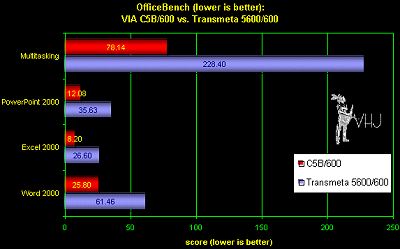JAMF tipte ons over een review van Van's Hardware waarin twee 600MHz low-end processors het tegen elkaar moeten opnemen. De eerste is de VIA C3, een 0,18 micron Socket370 chip gebaseerd op de Cyrix architectuur. De tweede deelnemer is de Transmeta TM5600, een chip met 512KB level 2 cache die vooral erg zuinig met stroom is. Voor de benchmarks van de Transmeta chip moest een Sony VAIO notebook gebruikt worden, omdat deze niet in een normaal moederbord gezet kan worden. De VIA processor kreeg wel dezelfde harde schijf en videocontroller, maar het C3 systeem gebruikte AGP kaart in plaats van een geïntegreerde PCI versie. Na een aantal bekende benchmarks wordt al snel een heel duidelijk contrast zichbaar tussen de chips. De games lopen duidelijk beter op het baksel van VIA en hoewel in statische benchmarks de FPU van de Crusoë superieur is, vertaalt dit zich absoluut niet naar real-world performance. Ook in de office benchmarks is de VIA meer dan twee keer zo snel, waarschijnlijk door het "Code Morphing" van de Transmeta:
Finally we look at OfficeBench scores. These are timed tests, so lower scores are better. As is readily evident, the Transmeta Crusoe profoundly lags behind the VIA C3 in these tests of Microsoft Office application performance. Again, the reason is that for the Crusoe to perform well, its emulation software ("Code Morphing" in Transmeta-speak) and application code must fit within its cache structure or performance degradation becomes severe. Sadly, this means that on most real world applications the Crusoe is very slow and certainly far slower than the inexpensize VIA C3 as is clearly demonstrated in the graph below.

